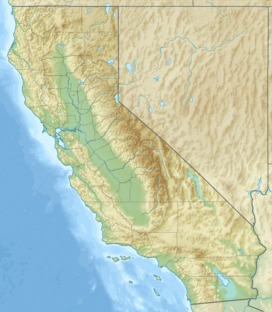Old Tejon Pass facts for kids
Quick facts for kids Old Tejon Pass |
|
|---|---|
| Elevation | 5,285 feet (1,611 m) |
| Traversed by | unpaved road |
| Location | Kern County, California |
| Range | Tehachapi Mountains |
| Coordinates | 34°59′21″N 118°32′43″W / 34.98917°N 118.54528°W |
The Old Tejon Pass is a special pathway through the Tehachapi Mountains in California. It connects the southern part of California with the central part. Long ago, this pass was simply known as Tejon Pass. It was a very important route for travelers and explorers for many years.
Contents
Where is the Old Tejon Pass?
This pass is found in Kern County, California. It's about 15 miles (24 km) northeast of the Tejon Pass we use today. The Old Tejon Pass sits high up between two canyons: Tejon Creek Canyon and Cottonwood Creek Canyon.
It's like a saddle between two hills. The pass is about 5,285 feet (1,611 meters) high. It is located between two peaks, one to the west (5,491 feet or 1,674 meters) and one to the east (5,566 feet or 1,697 meters).
History of the Old Tejon Pass
Early Trails and Explorers
Long ago, Native American people used a trail through what is now the Old Tejon Pass. A Spanish explorer named Pedro Fages found and explored this trail in 1772. Later, in 1776, a missionary explorer named Padre Francisco Garcés also used the pass.
In 1806, Lieutenant Francisco Ruiz named it Tejon Pass. He was on an expedition into the San Joaquin Valley. Ruiz also named Tejon Canyon and Tejon Creek. He chose the name "Tejon" because he found a dead badger (which is called tejón in Spanish) at the canyon's entrance.
In early 1827, the first American explorers to travel overland to California used this pass. This group was led by Jedediah Smith. They were guided by Native American people who knew the pass well. The group traveled from Antelope Valley into the San Joaquin Valley.
The Main Road to the Goldfields
A large Mexican land grant called Rancho El Tejón was established in 1843. Its main buildings were located below the pass, along Tejon Creek. Over time, a road developed that went straight north from Elizabeth Lake. This road crossed the western part of Antelope Valley and then went over the Old Tejon Pass.
This route was very important from 1849 until about 1854. It was the main road connecting Southern California to the goldfields in the north. Travelers would use this pass to reach the trail along the eastern side of the San Joaquin Valley.
A New Route is Chosen
In 1853, the U.S. Army surveyed the road over the Old Tejon Pass. They were looking for a good path to build the planned transcontinental railroad into California. The person in charge of the survey, Robert S. Williamson, found the road to be "one of the worst" he had ever seen. It was not suitable for a railroad.
Williamson preferred a different route further west, through Grapevine Canyon. He found this route much better for both railroads and wagons. Because of this, the name "Tejon" was moved to the new, better pass. This new pass became known as the "Fort Tejon Pass". It was a key part of the Stockton–Los Angeles Road.
After this, the Old Tejon Pass was used less and less. Eventually, it even lost its name on official maps. The "Fort" was later dropped from the new pass's name, and it became simply the Tejon Pass that we know today.


